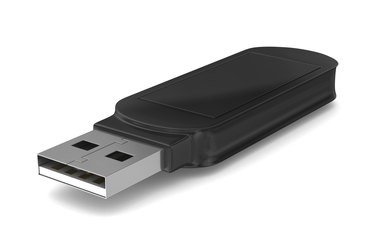
If you want to boot into the Norton Ghost recovery environment on a modern laptop, you might soon realize that Norton Ghost only allows you to create recovery CD's. Since most recent laptops do not come with a built-in CD or DVD drive, relying instead on the use of removable media, such as Universal Serial Bus flash drives. This can prevent you from accessing one of Norton Ghost's most important features: the ability to boot into a recovery environment. Fortunately, using Windows' built-in disk partitioning tool, it is possible to create your own bootable USB Norton Ghost recovery drive.
Preparing the USB Drive
Video of the Day
Step 1
Press the "Windows" key on your keyboard to open the Start screen and type "cmd".
Video of the Day
Step 2
Right-click on "Command Prompt" and select "Run as administrator." This will open the Windows Command Prompt utility.
Step 3
Insert the USB flash drive into a USB port on your computer.
Step 4
Type "diskpart" in the Command Prompt application and press "Enter." This will launch the Windows disk partitioning application.
Step 5
Enter "list disk" and press the "Return" key on your keyboard. Diskpart will now list all of the storage drives your computer has access to. In the first column, you will see the number that is assigned to each particular drive. Locate the number that has been assigned to the USB flash drive and note it.
Step 6
Type "select disk X", replacing "X" with the USB drive's number, and press the "Enter" key.
Step 7
Enter "clean" and press the "Return" key. Please note that, at this point, Windows will format your USB drive and erase whatever is saved on it.
Step 8
Type the following commands (without quotes), each of them followed by the "Return" key on your keyboard:
"create partition primary" "select partition 1" "active" "format fs=NTFS" "assign" "exit"
The Diskpart application will now close and you will return to the standard Windows command prompt.
Step 9
Enter the following command and press "Return:"
cd "C:\Program Files (x86)\Norton Ghost\Agent"
If you have installed Norton Ghost in a different folder on your hard drive, make sure to modify that command to reflect the location of the correct directory.
Step 10
Type "bootsect /nt60 X:", replacing "X" with the drive letter your computer assigned to the flash drive, and press the "Enter" key. If you do not know which drive letter your computer assigned to the drive, open Windows Explorer and locate the USB drive under "This PC." You now have a formatted USB flash drive that is ready to store the Norton Ghost recovery image. Close the Command Prompt window.
Creating the Image
Step 1
Launch Norton Ghost, open the "Tools" tab and select "Create Custom Recovery Disk CD."
Step 2
Click on the "Browse" button and select the CD or DVD drive that contains your Symantec recovery disk CD or the ISO image of that same CD. Click on "Next."
Step 3
Insert a blank CD in your computer's CD burner. Then select "Burn Symantec Recovery Disk to CD/DVD" and click on "Next" twice.
Step 4
Edit the Startup options if necessary and click on "Next." Select the appropriate regional settings for your Windows installation and click on "Next" twice.
Step 5
Select the appropriate license key option and click on "Finish." Norton Ghost will now burn the recovery disk onto the CD.
Copying the Image to the USB Drive
Step 1
Launch Windows Explorer.
Step 2
Click on your CD burner's drive in the left-hand pane and select all of its contents in the right-hand pane. Press "CTRL-C" on your keyboard.
Step 3
Select your USB drive from the left-hand pane of Windows Explorer, right-click anywhere in the right-hand pane and select "Paste." Windows will now copy your recovery disk to the USB key. You will now be able to use that recovery USB drive to boot into the Norton Ghost recovery environment.
- Technotes: How to Run Norton Ghost 15 From a DVD or USB Stick (Windows 7)
- Geeky Ramblings: Creating Bootable Ghost Recovery USB Flash Drive
- Norton by Symantec: Creating a Custom Symantec Recovery Disk in Norton Ghost 15.0
- SoftSea.com: Iso Opener Download
- 7-Zip: Download
- Disk-Tools.com: DAEMON Tools Lite v4.49.1 (With SPTD 1.86)